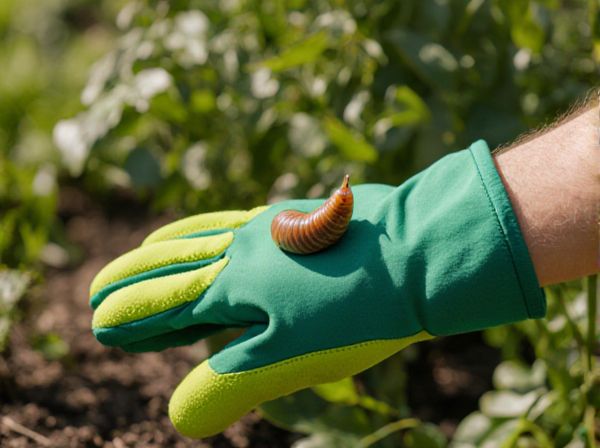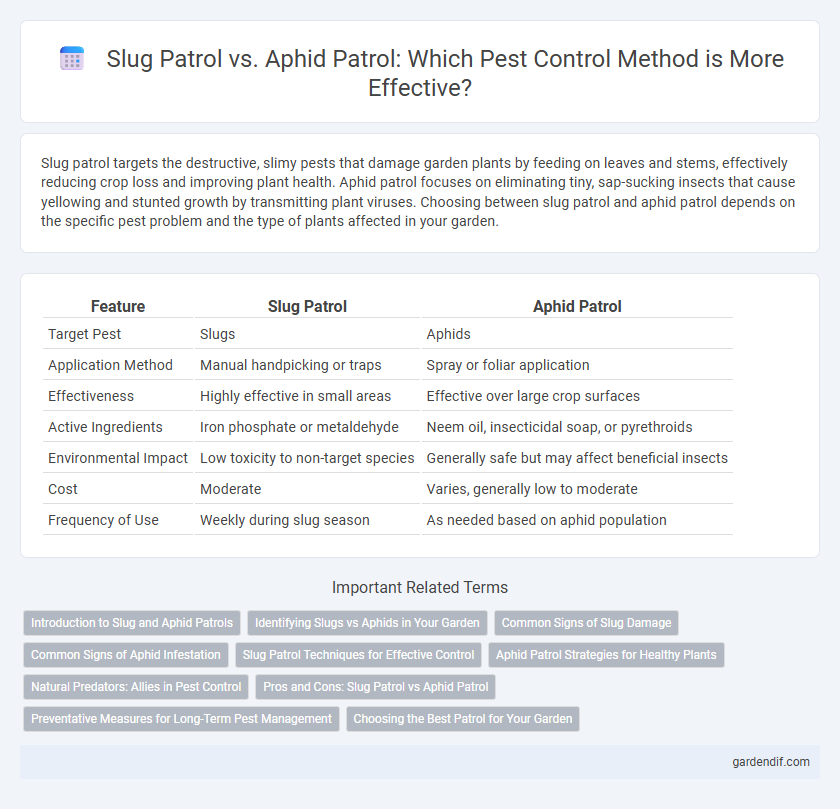
Slug patrol vs Aphid patrol Illustration
Slug patrol targets the destructive, slimy pests that damage garden plants by feeding on leaves and stems, effectively reducing crop loss and improving plant health. Aphid patrol focuses on eliminating tiny, sap-sucking insects that cause yellowing and stunted growth by transmitting plant viruses. Choosing between slug patrol and aphid patrol depends on the specific pest problem and the type of plants affected in your garden.
Table of Comparison
| Feature | Slug Patrol | Aphid Patrol |
|---|---|---|
| Target Pest | Slugs | Aphids |
| Application Method | Manual handpicking or traps | Spray or foliar application |
| Effectiveness | Highly effective in small areas | Effective over large crop surfaces |
| Active Ingredients | Iron phosphate or metaldehyde | Neem oil, insecticidal soap, or pyrethroids |
| Environmental Impact | Low toxicity to non-target species | Generally safe but may affect beneficial insects |
| Cost | Moderate | Varies, generally low to moderate |
| Frequency of Use | Weekly during slug season | As needed based on aphid population |
Introduction to Slug and Aphid Patrols
Slug Patrol and Aphid Patrol represent targeted pest control strategies designed to manage common agricultural threats. Slug Patrol focuses on reducing slug populations that damage crops by feeding on leaves and roots, while Aphid Patrol targets aphids known for sucking plant sap and spreading plant viruses. Both patrols integrate biological and chemical methods to enhance crop protection and improve yield quality efficiently.
Identifying Slugs vs Aphids in Your Garden
Slugs are soft-bodied mollusks that leave silvery trails and primarily damage leaves by creating irregular holes, especially during damp conditions. Aphids are tiny, sap-sucking insects found clustered on the undersides of leaves and new shoots, often causing yellowing and stunted growth. Effective pest control involves accurately identifying these distinct symptoms to deploy targeted treatments like slug baits or insecticidal soaps.
Common Signs of Slug Damage
Slug damage is characterized by irregular, slimy trails and large, ragged holes in leaves, often causing significant harm to tender plants. In contrast, aphid damage appears as distorted, yellowing leaves and sticky honeydew deposits that attract sooty mold. Identifying slimy residue and irregular plant holes is key for effective slug patrol in pest management.
Common Signs of Aphid Infestation
Aphid infestations commonly manifest as curled or yellowing leaves, sticky honeydew residue, and the presence of small, pear-shaped insects clustering on new plant growth. Unlike slug damage, which typically results in irregular holes and slime trails, aphids cause distortion and stunted growth due to sap extraction. Early detection of aphid colonies through these signs enables effective use of natural predators or targeted organic treatments to protect plants.
Slug Patrol Techniques for Effective Control
Slug Patrol employs targeted techniques such as handpicking, iron phosphate baits, and copper barriers to effectively reduce slug populations in gardens. These methods disrupt slug activity and prevent crop damage more efficiently than broad-spectrum aphid control approaches. Integrating moisture management and nighttime monitoring further enhances slug control outcomes.
Aphid Patrol Strategies for Healthy Plants
Aphid patrol strategies focus on natural predators like ladybugs, lacewings, and parasitic wasps to reduce aphid populations without harming beneficial insects. Implementing companion planting with garlic, chives, or marigolds deters aphids by disrupting their scent trails. Regular monitoring and early intervention, combined with organic insecticidal soaps, ensure healthy plants by minimizing aphid-induced damage to leaves and stems.
Natural Predators: Allies in Pest Control
Slug Patrol relies on natural predators like ground beetles and birds that target slugs, reducing chemical pesticide use and promoting a balanced ecosystem. Aphid Patrol harnesses beneficial insects such as ladybugs and lacewings, which feed on aphids and prevent infestations through biological control. Both pest control methods emphasize sustainable agriculture by enhancing natural predator populations to manage pest outbreaks effectively.
Pros and Cons: Slug Patrol vs Aphid Patrol
Slug Patrol effectively targets slugs by using bait that attracts and eliminates them, reducing damage to garden plants; however, it can sometimes harm non-target organisms, affecting local biodiversity. Aphid Patrol specializes in controlling aphids through insecticidal soaps or natural predators, minimizing plant damage without significant environmental impact, but it may require repeated applications for consistent results. Choosing between Slug Patrol and Aphid Patrol depends on the specific pest infestation, garden ecosystem, and sensitivity toward non-target species.
Preventative Measures for Long-Term Pest Management
Slug patrol employs barriers like copper tape and diatomaceous earth to disrupt slug movement, minimizing damage to young plants and nursery beds. Aphid patrol emphasizes the use of natural predators such as ladybugs and lacewings, alongside reflective mulches to repel aphids and reduce their feeding activity. Integrating these targeted, preventative measures supports sustainable pest management and reduces reliance on chemical controls for long-term garden health.
Choosing the Best Patrol for Your Garden
Slug patrol effectively targets mollusk pests by using bait traps and natural predators, preventing damage to leafy plants and seedlings. Aphid patrol focuses on controlling sap-sucking insects through insecticidal soaps, ladybugs, and neem oil, protecting flowering plants and vegetables from disease transmission. Selecting the best patrol involves assessing your garden's primary pests, plant types, and environmental conditions to implement targeted, sustainable pest control strategies.
Slug patrol vs Aphid patrol Infographic

 gardendif.com
gardendif.com